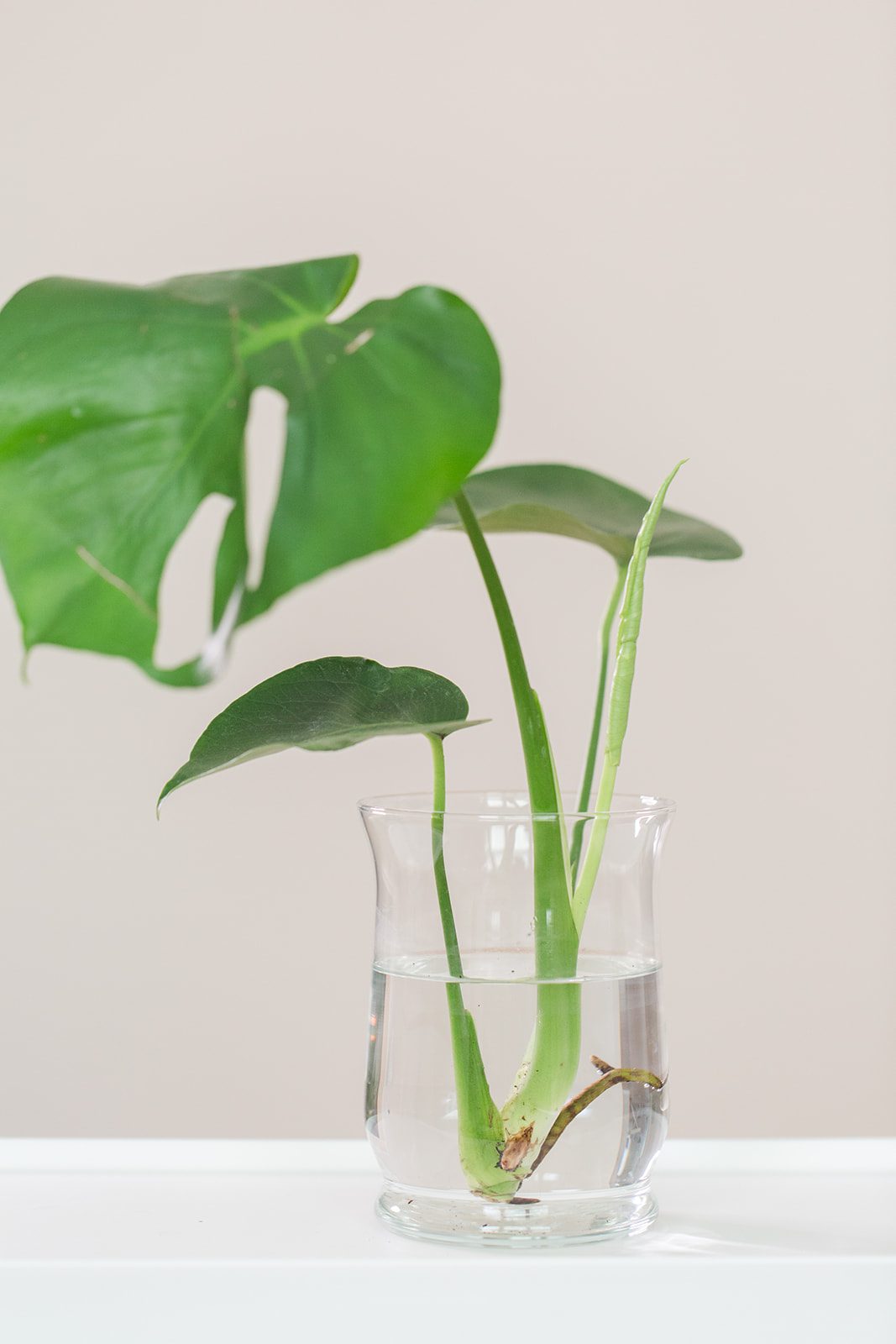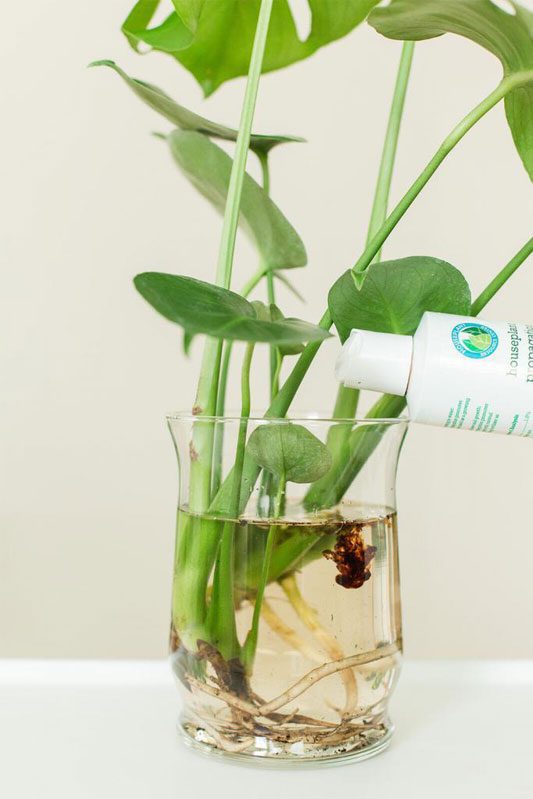If you love propagating houseplants (and why wouldn’t you?) you’ve probably tried a few different methods for cloning your favorite potted plants. One of the easiest and most common propagation methods—especially for aroids like monsteras—is to take cuttings.
The trouble is, you can’t just grow a whole new monstera plant with just any old cutting. Can you just propagate a leaf? Is propagating monstera without a node possible? Can you propagate with JUST a node?
In this article, we’ll clarify the ins and outs of propagating with stem cuttings so you can take the best cuttings that have everything they need to grow into a new, healthy monstera plant.
Table of Contents
Propagating Monstera Node Know-how
First, let’s clear up some common misconceptions about propagating with cuttings.
Can You Propagate a Leaf Without a Node?
In short, no. Your cutting MUST contain a node in order for it to grow new leaves.
You’ve probably swooned over gorgeous photos on Instagram and decorating magazines of a single monstera leaf in a beautiful glass vessel of clear water.
The bad news is that, while a leaf without a node may grow some roots, it will just be a rooted leaf. It won’t grow into a new monstera plant that will produce stems or more leaves. It will always just be one leaf.
The node contains all the genetic information necessary to grow a new plant, so the node is crucial for propagation.
Do All Monstera Leaves Have Nodes?
Nodes are little bumps that appear on the stem of your monstera on the opposite side from a leaf, but not on the leaves themselves or even the stems of the leaves.
Nodes form on the vine of your monstera. In fact, a young monstera might not have any nodes yet because it hasn’t grown enough. If your monstera looks like leaves growing straight out of the soil, it might not be mature enough to propagate with cuttings yet. (Though you might be able to propagate it with separation if it’s big enough!)
Once your plant starts to vine, most leaves will be accompanied by a node on the other side of the stem.
Can You Propagate Leafless Nodes?
So, you might not be able to propagate a leaf without a node, but you CAN propagate a node without a leaf!
You might see unrooted, leafless nodes for sale online. It’s a bit trickier than propagating cuttings with a leaf or two, though, and the success rate won’t be as high.
But it can be done!
How Do You Propagate a Node?
Whether you’re propagating a cutting with or without a leaf, there are steps you can take to ensure you get a good, viable cutting and increase your chances of getting it to root!
Selecting a Good Node
How do you get a good node? If you’re using a cutting with a leaf, it’s best to find at least one fairly young, healthy leaf rather than an older one.
It’s also helpful to look for axillary buds, especially if you’re attempting to root a leafless node. Axillary buds are tiny buds located in the axil of a plant leaf rather than on the opposite side of the stem where the node is. These will look like tiny green points. This is where the new leaves will grow! If your cutting doesn’t have a leaf, the axillary bud would be in the axil of where the leaf was. (Your cutting should contain the remnants of the leaf stem!)
While it is possible for a leafless node cutting to grow a leaf without a visible axillary bud, your chances are much better if the bud is already well-formed. If you’re buying node cuttings online, ask the seller if the cutting has an axillary bud. If they say no, you can give it a try anyway (especially if it’s inexpensive), but you may want to find a different source for cuttings.
Taking a Monstera Node Cutting
In general, it’s also best to take your cutting and propagate in the spring or summer when your monstera is likely to experience a growth spurt anyway. Take advantage of that growth!
Locate the area where you want to take your cutting. Again, a young, healthy leaf is best. These are also the most likely to have an axillary bud that’s ready to grow.
Make sure to use a sharp pair of shears or scissors, and take care to sterilize them with rubbing alcohol or hot water and soap to prevent potentially spreading infection to your plant.
Depending on the length of your monstera’s internodal spacing, try to cut between a half inch and an inch below the node so you have a decent chunk of stem on your cutting. (This also has the added benefit of keeping your cutting upright if you root in water. It’s like a little kickstand!)
How Long Does Monstera Propagation Take?
If your cutting is going to root, you should see little white buds starting to form within a few weeks. It can take up to three months (sometimes longer) for roots to be long enough to plant.
How to Get Your Monstera Cutting to Root
There are several different methods for rooting a monstera cutting, both for cuttings with or without leaves.
Here are some different setups and mediums you might want to try.
In Soil
Rooting in soil works best for cuttings with leaves. To do this, take your cutting and place it upright in a light, fast-draining soil like our Premium Monstera Potting Soil.
Use a small container with drainage holes like a small grower’s pot or planter. Keep the soil evenly damp by watering when the surface feels dry. Put the pot in a spot with lots of bright, indirect sunlight.
You can also mix a little Propagation Promoter into your water to encourage rooting and prevent infection.
You might also be able to root leafless node cuttings by laying them on damp soil inside a clear propagation box or in a planter with drainage and plastic wrap over the top. Make sure to keep the soil damp but not wet.
In Water
Only attempt this with a cutting that includes a leaf!
Place your cutting upright in a clear, clean glass container of water with a little Propagation Promoter mixed in. Put the glass in a bright place and change the water each week. Within a few months, your cutting should be ready to plant!
Sphagnum Moss
This method works best for leafless cuttings.
Lay the node cutting on damp sphagnum moss. Soak the moss in water and liquid fertilizer like Monstera Plant Food and wring it out so it’s not sopping wet. Keeping your node in a propagation box will also ensure that you won’t have to rewet the moss often. If you notice the moss drying out, simply remove the cuttings and resoak the moss in the water and liquid fertilizer solution.
Within a few weeks, you should start to see a leaf starting to sprout from the node, and maybe even some baby roots starting to bud! Once you have at least one leaf and roots that are at least an inch long, you can plant your cutting in soil. This could take a few months, so be patient!
Caring for a Monstera Node Cutting
It’s important to maintain the proper conditions for your monstera cuttings to give them the best possible chance at growing roots and turning into a grown-up monstera plant.
Here are some tips for helping your cuttings grow:
Rooting Hormones
Propagation Promoter encourages your cuttings to root by providing a boost of the natural rooting hormones plants produce when growing. It also protects your cutting from infections while they’re young and vulnerable, and nourishes the young cuttings while they’re developing new roots and leaves.
Mix a little into your water or growing medium to increase your chances of producing a successful propagation.
Temperature and Humidity
Keep temperatures between 70-80 degrees Fahrenheit to keep your node cuttings warm and happy.
Humidity is also helpful, especially for leafless cuttings that need to spit out new leaves fast.
You’ll also want sufficient humidity (as in above 60%) so your cutting’s first leaf will be healthy and unfurl properly without tearing. A terrarium or clear propagation box—or even tupperware with plastic wrap loosely draped over the top—works well for this.
Airflow is also important to prevent fungal growth that can kill your cutting before it has a chance to root or grow a leaf! Remove the plastic wrap or open your propagation box for an hour or two every day to promote airflow, and never tighten the plastic over the box. You’re aiming for a balance of heat, humidity, and airflow here. It can be tricky!
Cutting Light Requirements
It’s important to provide plenty of light to give your cutting as much energy as possible.
One challenge with propagating leafless nodes especially is energy. It takes energy to grow, and your monstera needs leaves to convert sunlight into energy. The first thing your leafless node will try to do is grow a leaf so it can start bringing in more energy.
Node Holder for your Monstera Cutting
If you have trouble keeping your cuttings upright in their container or medium, you should try these easy-to-use node holders. This handy propagation tool is a simple way to keep root cuttings healthy and in place while they take root, which gives those roots more room to grow without the added pressure of supporting the plant’s weight. This plant node support also helps your cuttings root faster!
Solved: Why Is My Monstera Not Propagating?
Sometimes cuttings don’t work. Much of the time it’s simply bad luck. But sometimes you can make tweaks to save your cuttings or coax them into rooting.
Here are some common issues that might stop your cuttings from growing.
Too cold.
If your cuttings are too cold or if the water they’re in is too cold, they won’t root. This is another reason why propagation tends to be more successful during warmer months! If you must propagate in the winter (like to salvage the healthy parts of a dying plant), try to keep your cutting in a warm room, but avoid putting it near a heater.
Not enough light.
Make sure your cutting gets at least 9 hours of bright, indirect sunlight per day.
The cutting was too old or unhealthy
If you took a cutting with an old or unhealthy leaf that’s not likely to grow anymore, it’s unlikely that the plant could create enough energy to root. It happens! Just take a younger one next time, and try to include an axillary bud.
Propagation Hack
If you have trouble keeping your cuttings upright in their container or medium, you should try these node holders! This is a simple trick for keeping cuttings healthy and in place while they take root, which gives those roots more room to grow without the added pressure of supporting the plant’s weight. Give them a try!
If at first you don’t succeed, propagate again!
Even if conditions are perfect, sometimes propagations just don’t work out. Don’t lose heart! Just try again. If you observed any problems the first time around, do what you can to correct them on your next attempt.
Once you do get a successful propagation, you’ll be hooked!
For more resources check out these links!






